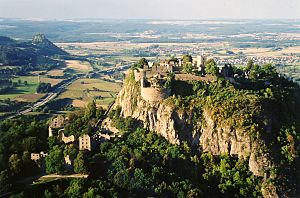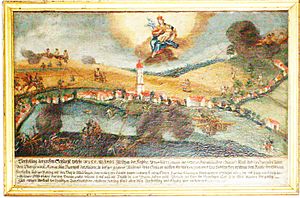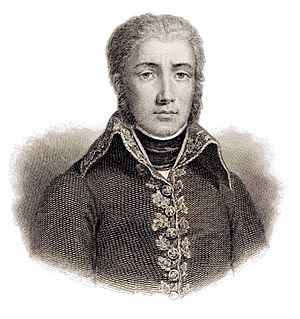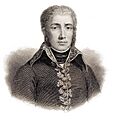Battle of Biberach (1800) facts for kids
Quick facts for kids Battle of Biberach (1800) |
|||||||
|---|---|---|---|---|---|---|---|
| Part of the French Revolutionary Wars | |||||||
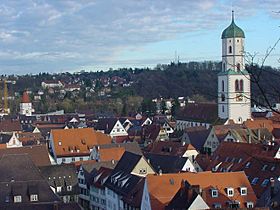 St. Martin's Church in the old town of Biberach |
|||||||
|
|||||||
| Belligerents | |||||||
| Commanders and leaders | |||||||
| Strength | |||||||
| 25,000 | 20,000 | ||||||
| Casualties and losses | |||||||
| 2,000 | 4,000 | ||||||
The Battle of Biberach happened on May 9, 1800. It was a fight between the French army, led by Laurent Gouvion Saint-Cyr, and the Austrian army, led by Pál Kray. The battle took place near Biberach an der Riss in what is now Germany.
The French won this battle. The Austrians lost twice as many soldiers as the French. After the fight, Kray's army had to retreat further east. This battle was part of the War of the Second Coalition, which was a bigger conflict within the French Revolutionary Wars. Biberach is about 35 kilometers (22 miles) southwest of Ulm.
In April 1800, a French army crossed the Rhine river. Their commander was Jean Victor Marie Moreau. On May 3, Moreau's army fought the Austrians at Stockach and Engen. Moreau captured the Austrian supply base, forcing them to retreat.
Just two days later, Kray's army faced the French again at Battle of Messkirch. But the Austrians were defeated once more. On May 9, Saint-Cyr's French soldiers caught up with part of Kray's army, leading to the Battle of Biberach.
Contents
Why the Battle Happened
The French Revolutionary Wars were a series of big conflicts. They involved France and many other European countries. These wars started after the French Revolution.
After some early battles, Napoleon Bonaparte led French forces to victory in Italy. This led to peace agreements, but they were hard to manage. Countries like Austria were slow to follow the rules of these treaties.
By early 1799, France was getting impatient. There were also new uprisings in other parts of Europe. France decided it was time for another military campaign. They planned to fight in northern Italy and southwestern Germany.
Armies Get Ready
At the start of 1800, French and Austrian armies faced each other. They were on opposite sides of the Rhine river. The Austrian commander, Pál Kray, had about 120,000 soldiers. His army included troops from Bavaria and Württemberg.
Kray placed most of his soldiers, about 95,000, in a key area near the Rhine. This area was shaped like an "L" where the river changed direction. Kray also put his main supply base at Stockach. This was a mistake because Stockach was very close to French-controlled Switzerland.
The French commander, Jean Victor Marie Moreau, had about 137,000 soldiers. About 108,000 of these were ready for battle. The rest guarded the Swiss border and French forts. Napoleon Bonaparte wanted Moreau to attack the Austrians from Switzerland. But Moreau had his own plan.
Moreau decided to cross the Rhine near Basel. This was where the river turned north. He sent one French group to distract Kray. This group crossed the Rhine from the west. Moreau's main goal was to outsmart Kray.
Battles Before Biberach
Moreau's army moved around Kray's forces. They managed to get behind the Austrian army. This left parts of Kray's army still guarding mountain passes.
On May 3, 1800, the French and Austrian armies fought at Engen and Stockach. The fighting at Engen was very tough for both sides. But while that battle was happening, a French general named Claude Lecourbe captured Stockach. This was a big loss for the Austrians.
Losing Stockach meant Kray had to retreat. He moved his army to Meßkirch, which was a better place to defend. But this retreat also cut off his path to Austria through Switzerland.
On May 4 and 5, the French attacked Meßkirch many times. But they couldn't break through. However, at a nearby village called Krumbach, the French took control of the high ground. This gave them a good view and position over Meßkirch. Because of this, Kray had to pull his forces back again. He moved his army to Sigmaringen, with the French following closely behind.
The Battle of Biberach
After the battles at Stockach and Messkirch, the French continued to chase the retreating Austrian army. On May 9, 1800, a part of the French army, led by General Laurent Gouvion Saint-Cyr, caught up with the Austrians near Biberach.
The fighting took place in the fields outside Biberach an der Riss. The French had about 25,000 soldiers. The Austrians, led by Pál Kray, had about 20,000 soldiers. It was a fierce battle.
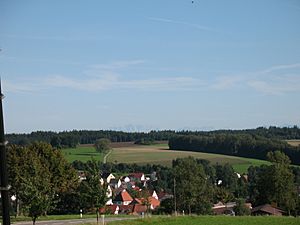
The French managed to defeat the Austrians. The Austrians suffered heavy losses, with about 4,000 casualties (killed, wounded, or captured). The French had fewer losses, around 2,000 casualties. After this defeat, Kray's army had to retreat even further. This French victory helped them push deeper into Austrian territory.
Images for kids
-
Fields outside Biberach an der Riss, where much of the fighting happened. In the distance, you can see the Zugspitze, Germany's tallest mountain.


